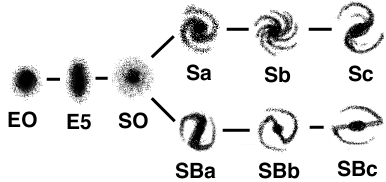Link back to Teacher's Page Teacher
Key for Student Worksheet
- Classifying Galaxies
- This is a statement about
galaxies: "All ellipticals are galaxies, but not all galaxies are elliptical".
After you learn how to classify galaxies, you will be able to explain what this
statement means. When scientists see objects in nature that share some features, but not
others, they find that grouping, or classifying them is a good idea. First they
must decide what scheme or plan they will use to decide to which group something belongs.
Your answers to questions below will come
from the online lesson: Classifying Galaxies.
-
- What is a galaxy?
- 1) billions of stars, dust and gas held together
by gravity.
-
- In the 1920's, an astronomer named Edwin Hubble was able to gather
pictures of many galaxies. He noticed that they were not all alike. He
decided to group, or classify them. To group the galaxies in the
photographs he studied, he could have used size, color, shape or any other
feature that he noticed. Hubble decided to classify galaxies by their shape
or form.
- Edwin Hubble looked at many galaxy pictures and decided to divide
galaxies into three types according to the way they looked. He used letters
to represent these three types of galaxies.
-
- 2)The letter "E" meant elliptical
galaxies,
-
- 3)"S" meant spiral galaxies,
and
-
- 4)"SB" meant barred spiral galaxies.
Galaxies had so many shapes
that Hubble found that three types were not enough. He had to further divide
these
three according to a slight variation in shape between each type of galaxy in each
category. For the
"E" or -
- 5) elliptical galaxies, he used the
amount of flattening or
-
- 6) roundness, elongation or stretching out,
from E0( E zero) to E5, to put the galaxies into smaller groups. For the
"S" or
-
- 7) spiral galaxies, he used how
tightly the arms were wound around the bright
-
- 8) center or nucleus to
further classify these galaxies as Sa, Sb, or Sc.
For the
"SB" or
-
- 9) barred spiral galaxies, he used
the increased openness of the
-
- 10) arms or spiral arms to
group these galaxies as SBa, SBb, or SBc.
-
- Edwin Hubble took all these ideas and presented them all together in a simple diagram
for classifying galaxies. This diagram is called the Hubble Tuning Fork Diagram. Most
galaxies fall into one of his groups, according to how they look. Draw a shape for each of
the types of galaxies below. Draw it above the letters which he used to identify the
shapes. (#11-19)
-

- 20) From the information you have seen today, explain the following statement: "All
ellipticals are galaxies, but not all galaxies are elliptical". Put your answer
below.
-
- Some ideas: there are several (three) main types of galaxies,
classified according to their shape. Galaxies have many different shapes. Only one type of
galaxy is elliptical; there are other types.
